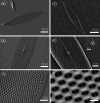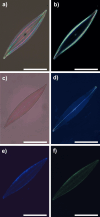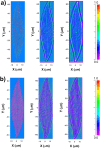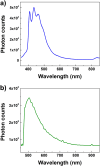Multiple-pathways light modulation in Pleurosigma strigosum bi-raphid diatom
- PMID: 38499606
- PMCID: PMC10948915
- DOI: 10.1038/s41598-024-56206-y
Multiple-pathways light modulation in Pleurosigma strigosum bi-raphid diatom
Abstract
Ordered, quasi-ordered, and even disordered nanostructures can be identified as constituent components of several protists, plants and animals, making possible an efficient manipulation of light for intra- and inter- species communication, camouflage, or for the enhancement of primary production. Diatoms are ubiquitous unicellular microalgae inhabiting all the aquatic environments on Earth. They developed, through tens of millions of years of evolution, ultrastructured silica cell walls, the frustules, able to handle optical radiation through multiple diffractive, refractive, and wave-guiding processes, possibly at the basis of their high photosynthetic efficiency. In this study, we employed a range of imaging, spectroscopic and numerical techniques (including transmission imaging, digital holography, photoluminescence spectroscopy, and numerical simulations based on wide-angle beam propagation method) to identify and describe different mechanisms by which Pleurosigma strigosum frustules can modulate optical radiation of different spectral content. Finally, we correlated the optical response of the frustule to the interaction with light in living, individual cells within their aquatic environment following various irradiation treatments. The obtained results demonstrate the favorable transmission of photosynthetic active radiation inside the cell compared to potentially detrimental ultraviolet radiation.
Keywords: Biophotonics; Diatoms; Nanostructured biomaterials; Photonics in nature.
© 2024. The Author(s).
Conflict of interest statement
The authors declare no competing interests.
Figures












References
-
- De Tommasi E, et al. Frontiers of light manipulation in natural, metallic, and dielectric nanostructures. La Rivista del Nuovo Cimento. 2021;44:1–68. doi: 10.1007/s40766-021-00015-w. - DOI
-
- Wu J, et al. Two-dimensional materials for integrated photonics: Recent advances and future challenges. Small Sci. 2021;1:2000053. doi: 10.1002/smsc.202000053. - DOI
-
- Chen S, Li G, Cheah KW, Zentgraf T, Zhang S. Controlling the phase of optical nonlinearity with plasmonic metasurfaces. Nanophotonics. 2018;7:1013–1024. doi: 10.1515/nanoph-2018-0011. - DOI
-
- Johansen VE, Onelli OD, Steiner LM, Vignolini S. Photonics in nature: From order to disorder. In: Gorb S, Gorb E, editors. Functional Surfaces in Biology III. Diversity of the Physical Phenomena. Springer; 2017. pp. 53–89.
MeSH terms
Substances
Grants and funding
LinkOut - more resources
Full Text Sources

